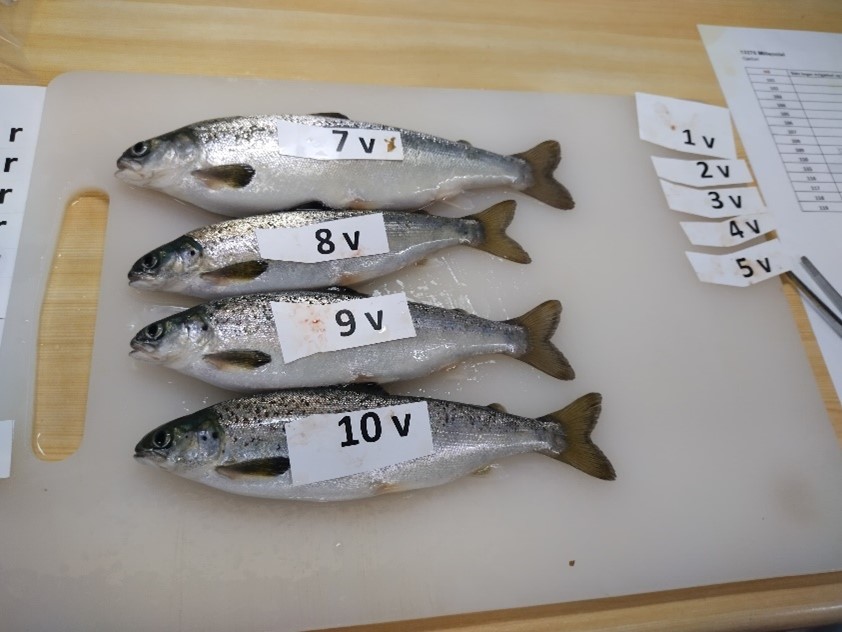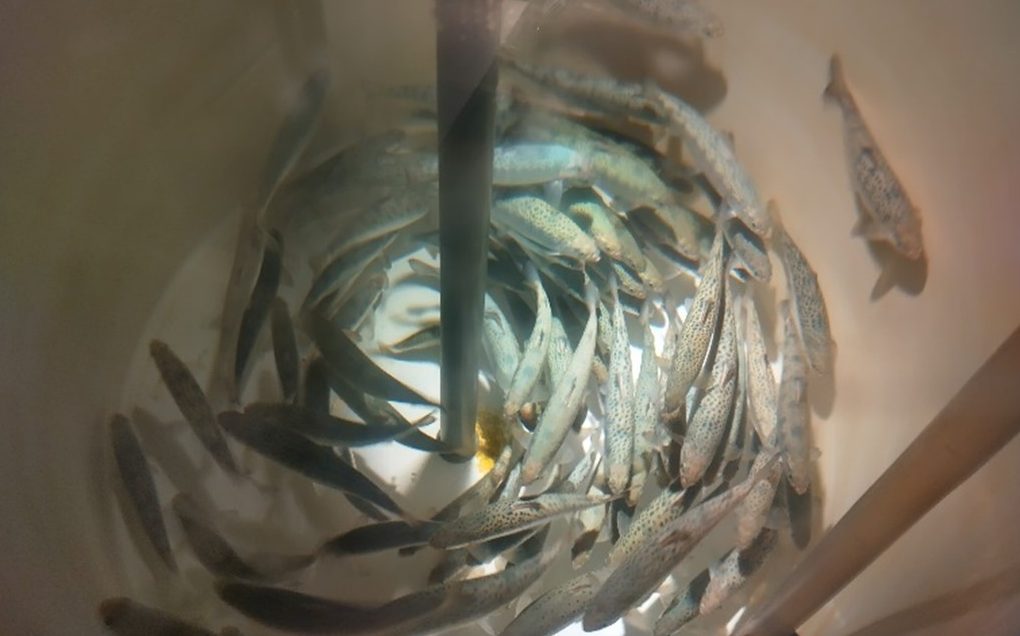Master student at NMBU

I am just about to finish my master studies in Aquaculture, at the Norwegian university of life sciences (NMBU). As part of my master studies, I have been an intern at NCE Seafood Innovation. And I have been tasked with presenting my master thesis for you readers.
I wrote my master in the autumn of 2022, and I was fortunate to be able to join an ongoing project called Millennial salmon with Nofima.
Thesis and hypothesis
The official title of my project was “Effects on growth and welfare of Atlantic salmon parr, feed diets with 10% BSFL meal, with different inclusions of BSFL stickwater.”
I had three hypotheses for my thesis, which are the following:
- Can the dietary incorporation of water-soluble proteins and free amino acids from black soldier fly stickwater, increase growth and welfare of Atlantic salmon?
- Can high concentrations of dietary manganese (Mn) induce up-concentration of Mn in the body and tissues of Atlantic salmon parr?
- Can high concentrations of dietary Mn have negative effects on fish performance and welfare?
BSFL and stickwater – what does it mean?
I assume not all readers are experts in salmon feed, and likely lots of readers are already quite confused already. What in the world is stickwater? Isn’t that just tree sap? And why are soldier flies involved? What war does flies have to fight? Are we at war with the flies? Isn’t high concentrations of manganese lethal?
Well buckle up, I will try to break down my thesis in such a way that anyone can follow, and hopefully learn something.
We are not at war with any flies, yet… though soldier fly is a specie of flies, for special interested people the latin name is Hermetia illucens. One of the largest biomasses on earth, is insects. Though to now, they haven’t been used much industrially.
Since 2017 the European commission has approved 7 species of insects, to be used in aquaculture feed. Among these is black soldier fly. Black soldier fly stands out amongst the other insects, as it contains large amounts of protein and fat, and has an amino acid profile, similar to fish meal.
Black soldier fly larvae or BSFL for short, can feed on agricultural waste, industrial waste and even manure, and use this to produce high quality feed ingredients. The BSFL creates a great opportunity for circular economy.
BSFL’s problem with maganese (Mn)
This almost sount too good to be true! Why aren’t we funding this? Well for one, we are funding this. And yes, it is too good to be true. Naturally there are always some challenges with new feed ingredients.
BSFL contains a significant amount of manganese or Mn. Is manganese dangerous? No, definitely not. Mn is an essential trace mineral and there is small amounts of manganese in almost everything you eat.
The EU legislation has set an upper limit of 100/mg per kg Mn in animal feed. Some BSFL meal can contain as much as five times that. It is not necessarily dangerous to have Mn levels above the legal limit, though it could potentially have an effect on the welfare of the fish. That is why we need students like me, to spend vast amounts of time, finding out if the fishes like what they eat, and if they are ok.
Stickwater?
Now you are all probably wondering what stickwater has to do with this. And what is stickwater? Stickwater is not tree sap, but it is a by-product from processing different meals. The easiest way to explain this, is to explain how fish meal is made.
In the process of making fish meal, bycatch, cut offs, heads, bones and all the stuff we do not eat, gets pressed hard with a hydraulic press, which removes as much liquid as possible. The liquid that is removed is called stickwater.
There are several methods to remove stickwater from different meals, and this can be done with centrifuges and even chemically. But stickwater is a by-product, and the meal is the sought after product.
While fish meal is frequently used in pet food, animal feed, and fish feed, in the past, it was common to just discard the stickwater. However, it was discovered that stickwater from fishmeal contains a lot of very valuable nutrients. Today stickwater is dried and added back to fishmeal to create a much better, more nutritious product.
BSFL is relatively new on the market. And new more efficient ways of processing it is being tested. In my master thesis the BSFL was processed similar to fish meal. Drying stickwater can be a very costly process. The scientists I worked with, and the company that produced the BSFL meal, wanted to know if it was beneficial to re-ad the BSFL stickwater, and if the benefits outweigh the cost of drying the stickwater. The BSFL stickwater contained very little dietary Mn, and adding more BSFL stickwater could potentially help lower the total dietary Mn levels of the BSFL meal.
Testing the hypotheses
How in the world can we test such hypotheses? Well, I will break down my methods for you.
First, I need fish feed! Nofima’s Aquaculture feed technology centre in Bergen produced 4 experimental fish feeds, and one control feed. Each experimental feed contained different levels of BSFL meal, with different inclusions of BSFL stickwater. The control feed was formulated similarly to commercial feed.
Now to actually test this we need fish! And loads of fish! And a place to have them, that is not the ocean… Testing experimental things in the ocean is a bad idea! There were no available fish nearby. So, me the student, was sent to Nofima’s Research Station for Sustainable Aquaculture in Sunndalsøra. Luckily the staff at Nofima had fed and taken care of my fish for eight weeks prior.
We began the trial with small parr weighing 25 grams and ended the trial with smolts of 80 grams. I lived in Nofimas research station for two weeks. The first couple days I fed my fish, and prepared the area for collection of samples.
Collecting samples
The main purpose of my thesis was to see if the feed effects the welfare of the fish. Well how do you statistically prove if a fish has good welfare or not?
It is not possible to just ask the fish… How do you collect samples from live fish? Well that’s the thing with science, sometimes you can collect nice samples of live fish. However, in this case we could not, so in the name of science we killed 1500 salmon smolts.
We euthanized them in a nice, gentle way. In this case I can’t really say no fish were harmed, death is usually defined as harmful. Though I can say that no fish suffered. And what an honourable death, not all fish can say they died for science!

Once my fish was dead, we stripped them for faeces. Collecting faeces from the fish can give us a lot of knowledge about, how well the fish digest the food, and what nutrients the fish does not use. And apparently the best way to do this, is to gently squeeze along the belly of the fish and collect the faeces in a cup.
After the fish were stripped for faeces, we did a welfare score. Could argue that a dead fish doesn’t really have good welfare. Welfare scoring is a system where we visually check the whole fish welfare issues, such as soars, deformities, scale loss etc. Each issue is scored based on severity, score 0 means that it is in perfect condition, score 3 means it is in awful condition. 30 fish per diet were welfare scored.
Then we removed some muscle tissue, liver, midgut and took a whole fish sample. That is done by taking a whole fish, and run it through a meat grinder a few times, and then you have a nice whole fish sample. Not very tasty, but gives us good values for the nutritional content of the whole fish.

In addition to all of these samples, we took x-rays of 30 fish per diet. Why would fish need x-rays? Well sometimes what we feed them, can cause deformities or other unwanted welfare issues. The best way to determine this is with x-ray.
I freeze dried all my samples, and then travelled back to Bergen to do analyse all my samples. All samples were analysed for nutritional content, and Mn content.
Now I can explain detailed how I analysed the samples, all the hours I was running around in a lab like a headless chicken, trying to get the right results. I could also spend many hours explaining how I did all my statistics, and all the blood sweat and tears that went in to creating nice graphs. But I think I will just let especially interested people read my thesis.
Now let’s get to the results!
Well, what did I figure out? The fish looked great! All the fish performed similarly. There were no statistically significant differences in welfare of the fish between diets. The fish feed BSFL stickwater, did not have significant better welfare, and did not grow any better than fish fed diets containing no BSFL stickwater. BSFL stickwater does not show the same promise as fish meal stickwater. The x-rays looked great! Though there was no correlation between deformities and diets.
The BSFL stickwater did water down the dietary Mn levels some. Though to come under the legal limit of 100mg/kg Mn in feed, we had to include much more BSFL stickwater than what the BSFL originally contained.
All the tissue samples were analysed to see where in the fish body Mn was deposited. If the Mn was deposited in bones, it would be significantly more in the whole fish sample. There were differences in Mn levels between different tissues. However, if we compared for example Mn in muscle tissue, between different diets, there were no significant differences. The only significant statistic I got, was that there were significantly more Mn in faeces from fish fed experimental diets, compared to control diet.
What I could conclude from this, is that the fish is excreting the excess Mn efficiently. Feeding fish diets containing high levels of dietary Mn does not lower welfare. Feeding fish diets containing BSFL stickwater does not increase welfare or growth.
Would I recommend BSFL as feed for salmon?
I am a little torn on this. In my thesis we feed the BSFL wheat husks, which can be used directly as animal feed. Currently there are very strict rules for what one can feed BSFL. The insects count as a production animal and does have rights. If we want to create a sustainable feed source, we need to feed the BSFL resources that cannot be used directly for human or animal consume. Manure and food waste are great food sources to raise BSFL, however the laws do not allow this today.
From all my reading of different sources, it seems that feeding fish diets containing more than 30% BSFL meal, lowers the fish welfare. I think BSFL can be a part of the solution, but BSFL alone cannot replace soy in salmon feed.
Read Erika’s master thesis here.
